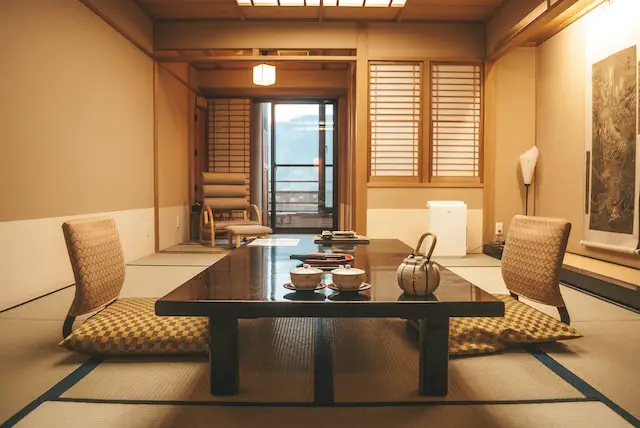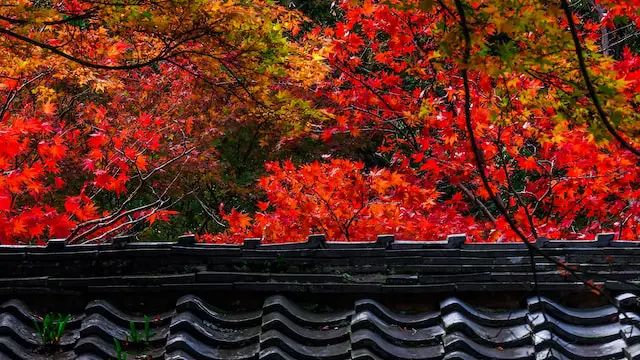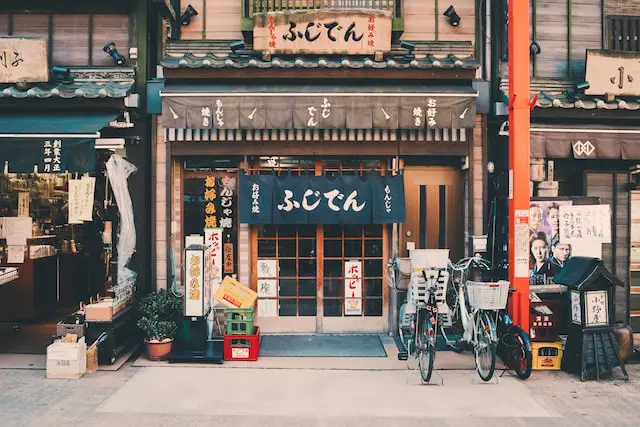In Japan, the authentic and traditional travel experience is incomplete without a stay in a Ryokan. This Japanese traditional inn dates back to the eighth century and represents a core part of Japanese culture and history. Ryokans offer guests a chance to experience a unique style of hospitality that’s distinct from western hotels and hostels.
These inns are significant in painting a vivid image of the country’s deep-rooted customs and ways of living, hence they are recognized as crucial components of Japanese tourism. Staying in a Ryokan is much more than just a night’s stay; it is an authentic Japanese experience that immerses you in traditional aesthetics, cuisine, and etiquette that have been preserved for centuries. In the following sections, we will further delve into the charm of Ryokans, their history, and the once-in-a-lifetime experience they provide.
The History and Evolution of Ryokans
Immerse yourself in the rich history of Ryokans, Japan’s traditional accommodation that dates back centuries. The birth of Ryokans can be traced as far back as the eighth century, during the Nara Period. Originally, these traditional inns were established along highways, serving as rest stops for weary travelers and monks.
In the Edo period (1603-1868), travel became more common owing to the stability of the era, and businesses and networks were extending across the country. This led to the evolution of Ryokans, with many springing up along transportation routes to cater to various societal ranks, from merchants to samurais. Some ryokans were modest and functional, while others were extravagant, offering luxurious comforts to those who could afford them.
As Japan modernized during the Meiji era (1868-1912), Ryokans faced stiff competition from Western-style hotels. Yet, their appeal remained in their ability to provide an authentic Japanese experience. They evolved to combine a traditional aura with modern comforts, offering guests a timeless retreat.
Today, the history of Ryokans continues to shape their fundamental ethos: omotenashi, or wholehearted hospitality. These traditional Japanese accommodations offer a unique peek into history, allowing visitors to experience Japanese culture from an intimate perspective.
Whether they’ve retained the minimalist beauty of their earliest designs or adapted with luxurious modern conveniences, Ryokans truly embody the evolution of Ryokans over time, steadfastly linking Japan’s past with its present.
The Unique Architecture of Ryokans
In your experience of Ryokan, Japanese Traditional Inn, one aspect that will undoubtedly capture your attention is the distinct and captivating architecture. A profound reflection of Japan’s commitment to preserving its culture, the architecture of Ryokan is a beautiful fusion of functionality and aesthetics, steeped in history and tradition.
A Ryokan design typically reflects the unique architectural style of sukiya-zukuri, which was originally used in tea houses. The structure is generally low-rise, with a seclusive entrance leading to a serene central garden, aiming to bring the outside nature in, harmoniously connecting man with the environment.
The interior design showcases a minimalist approach. Tatami mats are an integral part of the flooring, providing a soft and warm surface, accentuating the feeling of tranquillity. Paper thin sliding doors known as shoji separate rooms, blending aesthetics with functionality by allowing natural light to fill the rooms.
The Japanese Traditional architecture of Ryokans also provides a unique cultural understanding. Every element, from the landscaped garden to the humble tea room or the communal hot spring, is meticulously designed to inspire contemplation and serenity, epitomizing a way of life that values simplicity, nature, and harmony.
Every Ryokan visit is not just a stay, but a journey of immersion – into an era of timeless tradition, a serene lifestyle, and an art form that continues to captivate and inspire. Whether it’s a cozy inn in a bustling city or a luxurious retreat atop a peaceful hill, a Ryokan transforms an ordinary visit into an authentic Japanese experience.
Understanding the Ryokan Etiquette
Immersing oneself in the authentic Japanese experience is at its peak while staying in a Ryokan, a traditional Japanese inn. But, along with the wholesome experience comes the responsibility to observe the Ryokan etiquette. To make your stay pleasant and respectful towards Japanese manners, here’s a mini-guide to some notable etiquettes followed during a Ryokan stay.
Upon arriving, it is customary to remove your shoes at the entrance or genkan as part of the etiquette, symbolizing the act of leaving the outside world behind. Inside the Ryokan, wear the provided yukata (a type of kimono) and tabi (split-toe socks), which not only help you get into the spirit of traditional Japanese living but are also a part of the cultural etiquette in Japan.
Most ryokan rooms are furnished with a low table and futon bedding, which is spread out in the evening after the dinner. It’s respectful to keep your room tidy, and remember not to step on the tatami mats with footwear or place luggage on them.
Mealtime etiquette at a ryokan involves the act of consuming multiple small dishes in a specific order, an art in itself. Being punctual for meals, trying each dish, and drinking sake from small cups comprise some of the dining etiquettes.
Finally, while bathing in the public onsen, remember to clean yourself thoroughly before entering the onsen and avoid bringing towels into the water, as it is seen as contaminating the shared bathwater.
While these are just a handful of manners, they will greatly help your understanding and following the unique ryokan etiquette, enhancing your authentic Japanese experience.
Food and Dining in Ryokans
One of the many pleasures of staying in a Ryokan, a traditional Japanese inn, is the culinary experience it offers. Unlike your daily cuisine, a Ryokan provides an authentic opportunity to indulge in a Kaiseki meal, a traditional multi-course dinner meticulously crafted to reflect the passing seasons and local specialties.
The Kaiseki meal, an epitome of Japanese food culture, perfectly symbolizes the nation’s respect for nature, aesthetics, and the changing seasons. Every detail, from the selection of ingredients, the cooking techniques to the presentation, is carefully thought out including the beautiful ceramic tableware that corresponds with the meal and the season.
These dishes are prepared using fresh, locally sourced ingredients, and subtly reflect the flavors of the current season. A summer kaiseki, for example, might showcase the delicate taste of chilled sashimi and fresh seasonal fruits. Often, the meal is paired with sake; the local rice wine that enhances the dining experience in Ryokans.
The dining arrangement in a Ryokan is a unique experience too. Meals are typically served in the privacy of your own room, allowing you to fully immerse yourself in the tranquil atmosphere and the meticulous craftsmanship of each course. However, some Ryokans may invite you to dine in a communal dining hall, providing an opportunity to interact with other travelers.
In summary, dining in a Ryokan is much more than mere sustenance – it’s an authentic Japanese food culture that appeals not just to your taste buds, but also your sense of sight and spirituality. As such, it only makes the Ryokan stay unmissable for those seeking to experience the heart of Japan.
For many travelers, the allure of Japan isn’t just in its bustling cities and historical sites, but also in unique experiences like the Onsen experience. And when it comes to immersing oneself in these thermal hot springs, nothing matches the tranquil environment and amenities offered by Ryokan onsens.
An essential part of the allure of staying in a Ryokan, Japanese traditional inn, is the unique opportunity to soak in an Onsen. These therapeutic hot-springs offer a healing soak, believed to rejuvenate the body and soothe the spirit. A hot soak in these mineral-rich waters, while gazing at the backdrop of a gracefully manicured garden or a serene mountain landscape, provides a perfect escape from daily life, creating a sanctum of peace and tranquility in the hustle and bustle of life.
Not to be confused with a commonplace bath, the techniques and rituals inherent in the Japanese hot springs experience are integral to the culture, and Bathing etiquette must be adhered to. So, before entering an Onsen, travelers are advised to thoroughly cleanse themselves in order to maintain the purity of the shared waters.
The Onsen baths in Ryokans are frequently segregated by gender, and many inns offer private onsens for guests seeking seclusion or for families. The Ryokan Onsen is an integral part of the authentic Japanese experience, a timeless tradition that marries relaxation with introspection.
With a rich array of Ryokans boasting unique Onsen experiences across the country, whether in snow-capped landscapes or subtropical locales, the possibilities to encounter this deeply rooted cultural tradition are plentiful and diverse.
Traditional Japanese Activities in Ryokans
Central to the authentic Japanese experience in Ryokans are the traditional activities they offer. Going beyond the physical comfort, Ryokans ensure you have a deeper understanding and appreciation of Japanese culture.
One such activity is the tea ceremony. This is more than an act of sipping tea, it symbolizes tranquility and mindfulness, fundamental aspects of Japanese philosophy. The host skillfully prepares and serves matcha tea, promoting a peaceful atmosphere.
If you want to experience Japanese artistic ingenuity, try your hand at Origami. This fascinating art form of paper folding has been a part of Japanese culture for centuries and allows you to create beautiful structures from just a piece of paper.
Another activity offered by certain Ryokans is calligraphy. This is not simply about writing but is considered an art form where each stroke enhances spiritual concentration and aesthetic fulfillment.
These activities offer a deeper immersion into the Japanese way of life, hence making your stay in Ryokans an enlightening cultural journey. Participation in such activities is not mandatory but is highly recommended to enhance your experience.
Top Ryokans to Visit in Japan
If you’re planning your Japanese travel experience and wish to immerse in authentic Japanese culture, booking a stay at a traditional Ryokan, or Japanese inn, should be at the top of your to-do list. Here is a curated selection of some of the best Ryokans across Japan for your consideration:
1. Tawaraya Ryokan, Kyoto: This Kyoto Ryokan is a premier destination in Japan and renowned worldwide. The charm of Tawaraya lies in its meticulous service, elegant architecture, and serene gardens.
2. Gora Kadan, Hakone: Formerly a summer villa for the Kanin-no-miya family, this Ryokan now offers a luxurious onsen experience with a mesmerizing view of the seasonally changing landscape of Hakone.
3. Hoshi Ryokan, Komatsu: Touted as one of the oldest hotels in the world, Hoshi Ryokan’s ambiance and service takes you centuries back and paints a vivid picture of traditional Japan.
4. Asaba Ryokan, Shuzenji: This Ryokan is set on a private pond, and each guest suite has access to idyllic views. Its age-old tea ceremony tradition is something not to miss.
5. Takaragawa Onsen, Minakami: Known for one of the largest outdoor hot springs (onsen), Takaragawa Ryokan also provides a splendid view of the surrounding valley and river.
No matter which one you choose, these Ryokans represent the best of Japan’s timeless hospitality, offering a cultural immersion that is priceless for tourists. Be sure to advance book, and look out for the unique activities each Ryokan offers.
Tips for Booking a Ryokan
If you are planning a trip to Japan and desire an authentic Japanese experience in your accommodation, then a stay in a traditional Ryokan is a must. Here are some helpful tips for choosing the right Ryokan that suits your needs and expectations:
Firstly, decide on the locality – Ryokans are spread across the country, from vibrant cities like Kyoto to tranquil countryside settings. City Ryokans offer the advantage of easy access to popular attractions, while countryside Ryokans provide a relaxing escape surrounded by natural beauty.
Secondly, keep your budget in mind. There are a wide range of Ryokans, from budget-friendly options to luxury ones. The price usually increases with the quality of service, dining experience, and room size. Some luxury Ryokans can offer private gardens or hot springs in your personal suite, creating an opulent and private oasis of tranquility. Conversely, budget-friendly Ryokan can offer a homely and simple atmosphere that provides deep insight into traditional Japanese lifestyle.
Furthermore, take into consideration the amenities offered. Most Ryokans provide an Onsen experience or hot springs which is a quintessential part of the Ryokan stay. If you have specific dietary requirements, check if the Ryokan’s in-house dining offers options that cater to your needs.
Finally, ensure to read through reviews and take recommendations before booking a Ryokan. This will help you gauge the hospitality and overall experience offered by each Ryokan.
Choosing the right Ryokan is crucial to truly immersing yourself in the Japanese culture and lifestyle. With careful planning, your Ryokan experience will be a memorable part of your Japanese journey.
Conclusion
In conclusion, the unique charm of Ryokans plays a pivotal part in the authentic Japanese experience. A Ryokan stay allows visitors an insight into a side of Japan that reverberates with tradition and introduces them to the quintessential Japanese concept of ‘omotenashi’ or selfless hospitality.
Whether you’re soaking in an onsen or enjoying a meticulous Kaiseki meal, Ryokans offer undiluted and enriching Japanese experiences that extend far beyond typical accommodation. Prominent in tourist destinations like Kyoto, these traditional Japanese inns range from budget-friendly to luxury, making them accessible for different types of travelers.
For those planning their Japan travel, make sure to include a Ryokan stay in your itinerary. Immerse yourself in Japan’s timeless hospitality and traditional lifestyle, and let the Ryokan experience be your annex to the illustrious narrative of the Japanese culture.




